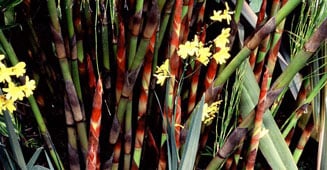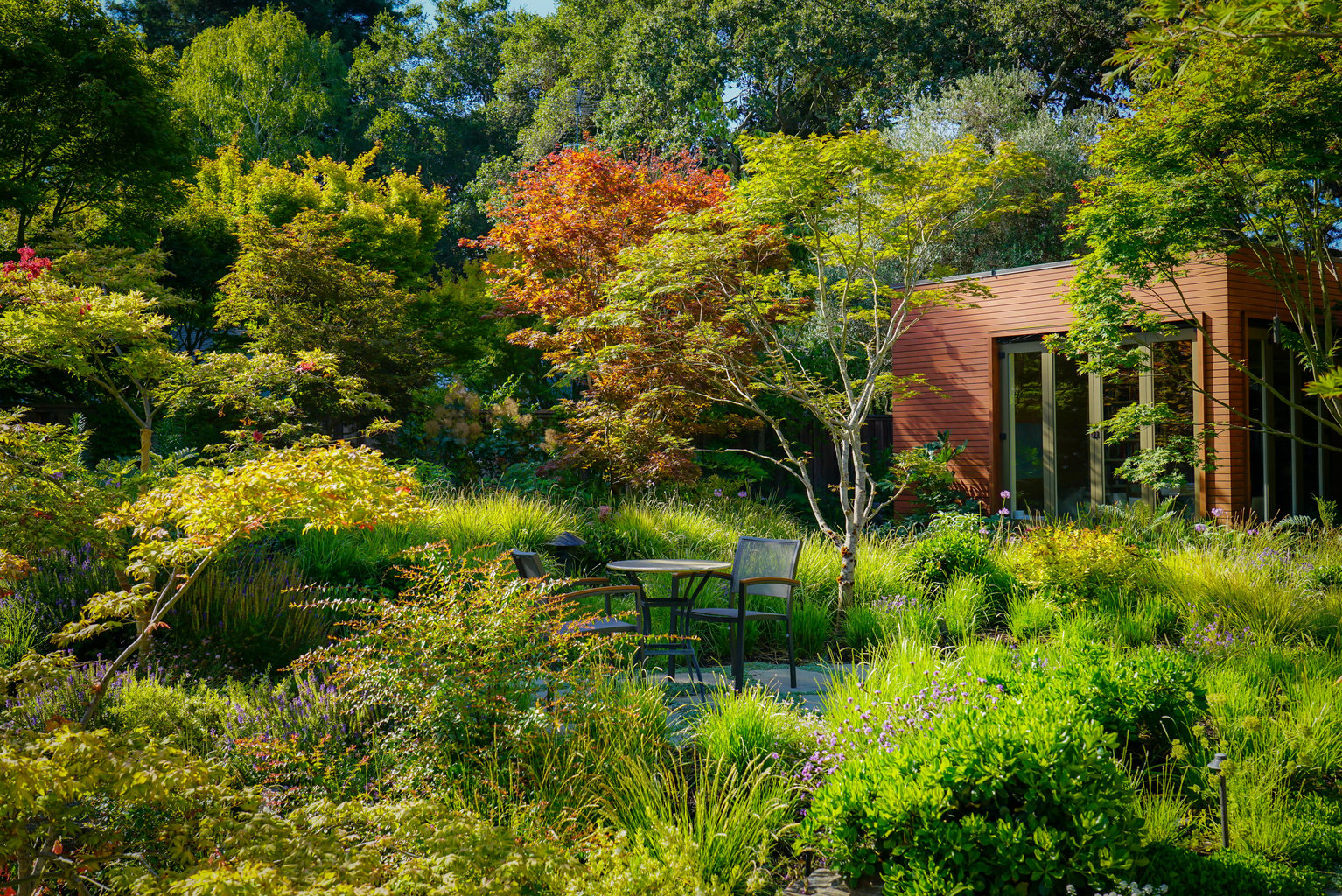

Contributor
- Topics: Archive, Plants You Need

Gardeners find the textures, architecture, and flowering tassels of South African restios—plants in the family Restionaceae—appealing. Swaying, unbranched species move like kinetic sculptures in the wind.
Overall growth resembles bamboo, with upright culms ascending from a network of underground rhizomes. Like bamboo, there are running restio species, but those generally available in the western United States are densely clumped or spread only moderately.
Juvenile plants may begin as a mass of finely branched fluff, gradually growing to tall, unbranched reeds; many species remain finely branched with maturity. Leaves are reduced to scales or bracts, and stems take on the task of photosynthesis. Stem color ranges from chartreuse through dark green to powder blue. Almost all species are dioecious, having separate male and female plants with differing flower tassels.

With one exception, the family Restionaceae is restricted to the Southern Hemisphere with centers of diversity in South Africa and western and southern Australia. In South Africa’s Western Cape, the plants are a feature of the fascinating and diverse fire-determined plant community referred to as fynbos (fane-boss). Restios are a common backdrop to showy proteas and ericaceous plants. Until the mid 90s, only a few South African restio species were in cultivation, specifically those with seeds that germinated readily without treatment, such as Elegia capensis. A greater variety of species entered the trade after it was found that chemicals in smoke could satisfy seed dormancies in many fynbos plants. Botanist Neville Brown and horticulturist Hanneke Jamieson created a planting at Cape Town’s Kirstenbosch National Botanical Garden that demonstrates how wonderful restios look in mass plantings. The stage was set for the plant’s entry into California horticulture with Neville Brown’s development of Smoke Plus, a product now sold internationally, and an increased variety of seeds offered by Silverhill Seeds.
1 De Lange J H and Boucher C (1990) Autecological studies on Audouinia capitiata (Bruniaceae). I. Plant-derived smoke as a germination cue. South African Journal of Botany 56, 700-3
Brown N A C (1993) Promotion of Germination of Fynbos Seeds by Plant-derived Smoke. The New Phytologist Vol. 123, No. 3 (Mar., 1993) pp. 575-583

There’s a lot to learn about plants that are this new to horticulture, and we are still learning about restios. We do not yet fully appreciate their ecological range, nor do we know their precise horticultural limits. Most species are native to windy, exposed sites, while some grow in forest margins or dense, late successional fynbos and tolerate considerable shade. Most are found in nutrient- poor, acidic soils, but there are some that grow in the richer soils of renosterveld—a rich soil sister to fynbos in the Western Cape. Some species grow in saline coastal soils, or alkaline, limestone-derived soils, which should be more adaptable to California’s dominant soil types. Although the Western Cape has a mediterranean climate with summer drought, it is the wettest of the world’s five mediterranean zones, while California is the driest.
Plants from the southern coast or mountains in South Africa may get rain any month of the year, but heading inland on the poorly explored north-facing slopes, and where fynbos meets the Klein Karoo, there should be species with the drought tolerance needed in California. Because restio habitats are adapted to episodic wildfires, gardeners should be mindful of factors that affect maintenance in cultivation, such as the buildup of senescent material for fuel, and divergent strategies of renewal from seed vs. resprouting after the flames.
We also should bear in mind that the Southern Hemisphere is buffered from temperature extremes by vast expanses of ocean. Cold hardiness ratings from our colleagues south of the equator need to be recalibrated here in the more continental north.

Being adapted to low nutrient levels allow restios to grow in soils of extremely low fertility. Botanists have traditionally described Restionaceae as having a two-part root system with coarse, colonizing roots, followed by extremely fine, cobweb-like roots. More recently these fine networks have been described in better detail and are called capillaroid roots, with very long root hairs to increase surface area for nutrient absorption in the absence of mycorrhizae. The downside of this ability to scour scarce nutrients is that excess nutrients, typically phosphate, can lead to toxicity and plant death. Restios thrive with only trace amounts of phosphate; supplemental fertilizers inhibit root growth, promote increased branching, “slouching” growth, yellowing, and tip burn. Water stress and high soil temperatures may also cause yellowing.
Currently, restios grown in California have very few pests or pathogens, unlike in South Africa, where they are parasitized by bud galls and nibbled by caterpillars. Soft growth in greenhouses may be attacked by aphids and, when under-potted, congested root systems may form a solid mass that excludes water. Continuously saturated, overcrowded conditions and sour soil result in rapid root loss and decline. In such cases, the plants may be saved by cutting away the outer portions of the root ball and replanting in fresh soil with adequate room.


Botanists are learning about restios right along with horticulturists, so we must be patient with name changes that will ultimately reflect the true evolutionary relationships among these plants. Recently a number of genera were transferred: Chondropetalum is now included in Elegia—Chondropetalum tectorum is now Elegia tectorum, and Ischyrolepis has been absorbed into Restio. These changes make sense scientifically. Botanists had thought that hybridization did not occur in restios, but I have discovered hybrid swarms between distinct Cannomois species in nature and have made artificial hybrids between C. grandis and C. congesta. The world’s Restionaceae expert, Dr. Peter Linder, tells me he intends to investigate this; it’s likely that hybrid seed was included with the introduction of C. grandis to California (under the now incorrect name, C. virgata, more recently segregated as a much shorter, running species.)

Invasiveness issues should be considered for any new species entering cultivation. Restio characteristics that favor invasion include long-lived, dormant seeds that wait for fire to germinate. Thamnochortus insignis has shown invasive tendencies in South Africa, where it is commonly planted outside its natural range. With a fair frost tolerance and the ability to adapt to various soils, T. insignis seedlings have spontaneously appeared in California gardens when both male and female plants are present. Running species should be handled with care to avoid unintended rhizome fragmentation.

Overall, the invasive potential of South African restios in California is unlikely because dioecy requires both sexes for seed set, and single plants do not establish populations. Even when plants of both sexes are present in the same garden, seed set may fail without dusting pollen directly on female plants because restio pollen is too heavy to travel far without the high winds of their native habitat.
Furthermore, nutritional sensitivities, such as phosphate toxicity, limit the growth of many restio species in California soils. And low pH is required for most, while California soils are commonly neutral to alkaline clays.
And finally, most restios have limited means of vegetative reproduction, although I have found culm layering to occur spontaneously in the juvenile plants of Elegia filacea, Rhodocoma capensis, and a few others.

Some of the author’s favorite restios available in the trade.
[sidebar]Silverhill Seeds www.silverhillseeds.co.za
Smoke Plus
www.capeseed.com [/sidebar]
Elegia elephantina. Drought-tolerant, soil adaptable, spreads moderately, long-lived, very easy to divide, introduced to California as E. tectorum, but distinguished by larger diameter culms and a spreading habit.
E. tectorum. Drought-tolerant, soil adaptable, long-lived, dark green unbranched culms, already widely planted.
Restio quadratus. Moderately drought-tolerant, shade-tolerant, soil adaptable, spreads moderately, extremely fine texture with annual regrowth at nodes for increasing fluff.
R. subverticillata. Drought- and shade-tolerant, soil adaptable, dark green whorled branches added to each season.
Rhodocoma capensis. Drought-tolerant, soil adaptable, dark green whorled, short branches added each season.
Thamnochortus insignis. Drought-tolerant, soil adaptable, rapid transition from branching juvenile plants to unbranched mature phase, watch for invasive behavior.
T. lucens. Drought-tolerant, soil adaptable, moderate size, rapid transition from branched juvenile plants to unbranched mature phase, moderate size.
T. spicigerus. Drought-tolerant, soil adaptable, spreads moderately.

Other favorites not commonly available—except perhaps from the author—include:
Anthochortus crinalis
Askidiosperma paniculatum
Cannomois grandis
Elegia macrocarpa
Restio sieberi
R. subverticillata
Thamnochortus acuminatus
T. fruticosus
Share:
Social Media
Garden Futurist Podcast
Most Popular
Videos
Topics
Related Posts

Low Maintenance Gardens – Better for Pollinators and People
Autumn 2022 “I come out every day. It’s therapy, my meditation.” Janet’s young garden transformed from overgrown, invasive plants to mostly natives. The dailiness of

Invasive Plants Are Still Being Sold: Preventing Noxious Weeds in Your Landscape
Autumn 2022 With so many beautiful ornamental plant species and cultivars throughout California and the Pacific Northwest, how do you decide which ones to include

Garden Design in Steppe with Transforming Landscapes with Garden Futurist Emmanuel Didier
Summer 2022 Listen to full Garden Futurist: Episode XVII podcast here. Emmanuel Didier, Principal and Creative Director at Didier Design Studio is a leading figure

Seslerias: Versatile Groundcover Meadow Grasses
Summer 2022 Without question, the most beautiful and versatile of all the groundcover meadow grasses are the moor grasses (Sesleria). Moor grasses tick off all









